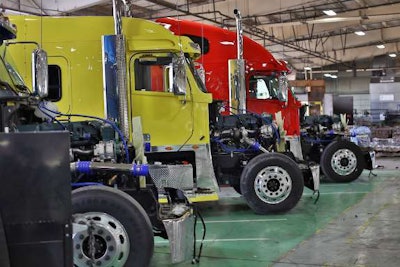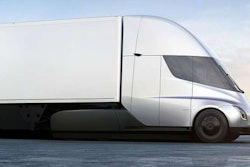The period for truckers and others to file formal comments on an EPA proposal to rollback Obama-era emissions regulations placed on glider kit vehicles closed at midnight Friday.
The EPA in November issued a proposal to exempt glider kit vehicles from the Phase 2 tractor-trailer emissions standards finalized in 2016. The EPA’s plan would reclassify glider kits as non-new vehicles and rescind the glider-specific portions of the Phase 2 standards. The rest of the Phase 2 rule would remain in tact.
The regulations call for about a 25 percent reduction in emissions of greenhouse gases of tractor-trailer vehicles by 2027. The glider kit portions of the rule would have, for the first time, brought gliders under the purview of the EPA and its emissions standards. The new standards for glider kit vehicles would have required builders of such trucks to reshape their businesses and their products to meet the Phase 2 restrictions, despite only accounting for less than 5 percent of new truck sales each year.
Here are some of the comments made about the proposed change:
 Work in process at Fitzgerald Glider Kits
Work in process at Fitzgerald Glider KitsTerry Leckel: As a small trucking company (50 trucks), glider kits have become an invaluable resource to keep us competitive with the bigger trucking companies. Number one, cost: With trucking costs, especially in the Class 8 market, going up, glider kits provide us with a way to keep our fleet updated. Number 2, breakdowns: The reliability of trucks produced over the last 10 years, due to emission laws, is measurably lower than the quality of trucks produced prior to 2008. Frankly speaking, I have twice the number breakdowns with emission-complaint trucks vs. glider kits of the same model year. Please allow us, small family owned businesses, to continue to operate and provide quality trucking services to our loyal customers.
Travis Brown Trucking LLC: We have a fleet of 12 trucks. We run 80 percent gliders. They outperform and get better fuel mileage than new trucks with all the emissions on them. There have been a lot of small companies go out of business because of the new emission standards on new trucks. They are junk. They are always breaking down. Please look into what I am saying about this.
Chris Bruckner: I am the dealer principal of Bruckner Truck Sales. We are a dealer for Mack and Volvo trucks. I am a private business owner that is based in Texas with 26 locations spread across Oklahoma, Kansas, Colorado, New Mexico and Louisiana. As a dealer of heavy-duty trucks I employ close to 900 people selling parts, service, truck sales and leasing. I ask EPA to keep the volume cap on “glider vehicles” as prescribed in the final Greenhouse Gas Phase 2 regulation. Bruckner’s is forced to compete for customers with dealers of glider vehicles, who have a significantly unfair competitive advantage. I know of several fleets in the area we serve who have, in the past, purchased new trucks from us that are now buying gliders. These gliders are being built with old, non-compliant diesel engines. Fleets do this to pay a greatly reduced price on a truck (up to 20 percent), plus they can run an engine without new emission technology. The same technology that the EPA mandated all truck manufacturers complies when building trucks. Simply put, gliders do not meet today’s environmental or safety requirements. One example is a customer who purchased a new Volvo from Bruckner in 2012. His first new truck saved him so much in better fuel economy he was able to buy a Corvette and put his son through school. When it came to trade his truck with 1.1 million miles, he decided to purchase a glider. The customer did this because of his cost saving between the glider and another new Volvo. This is an unlevel playing field for dealers across the country and it flies in the face of the EPA’s own rules. Finally, we as dealers are required to collect a 12 percent federal excise tax on the sales price for every truck we sell. Purchasers of glider vehicles often do not pay the excise tax. This tax is used to fund the Federal Highway Trust Fund which helps pay for our roads and bridges. So, we are at an unfair 12 percent price disadvantage, and additionally we miss out on the sales of the very vehicles that would be deployed in the construction and repair of highway infrastructure because the fund is reduced with every glider vehicle sold.
Chad Smith: Glider kits and glider/pre-2004 engines saved my company. I have a 31-truck company. In 2013 I had 17 trucks (all 2007 and newer) and they nearly put me out of business. I was lucky if nine of the 17 were running at any given time. I had one engine catastrophically destroy itself to the point of the truck not being worth the cost of repair. That’s when I purchased my first glider. From that point I purchased and built gliders from wrecked or worn out trucks. The reliability and fuel efficiency far exceeded the trucks I had been running. This allowed me to provide much better service and expand my business. I employ more drivers and am able to pay them higher wages due to less downtime and fuel usage. I am in the recycling business and it also makes me feel good to be able to bring new life to used engines and transmissions that otherwise would be sitting in a junk yard.
Matthew Hampton, Hampton Trucking LLC: Our family business has been in the trucking industry since 1953. We have been buying glider kits since 2014. Since trading in our 2012 and 2013 vehicles for Glider Kit trucks we have seen an increase in fuel economy and a reduction in cost, down time, maintenance, and oil consumption. On average the Paccar MX-13 and the Cummins ISX-15 engines with emissions controls and DPF got 4.75 to 5.25 MPG. They were a constant fire hazard during the “re-gen” process along with the overwhelming cost of maintenance on the emissions systems. By using Glider kit trucks we are able to purchase and maintain our trucks in house with tools and training that we already possess cutting our maintenance costs by nearly half. The Glider Kit Trucks we currently buy from Fitzgerald Glider Kits with the 60 Series Detroit engines are averaging 6.25 to 6.75 MPG with little to no down time and a much lower cost of operation. Not only is the up front cost of ownership of a Glider Kit much less than that of a new EPA compliant truck the cost of ownership for the life of the vehicle is less than half. EPA compliant trucks have a life expectancy of 3-5 years before they become so expensive to maintain that most owners must sell or trade them in for far less than actual value. Whereas Glider Kits and pre-2007 trucks last 20 years and retain much more of their value with proper upkeep and maintenance. Thank you for your time and consideration in making a common sense approach to an issue that can negatively affect our industry and the economy.
John Bangs: As an owner operator, glider kits are affordable way to upgrade my equipment. Please keep glider kits legal and available. Going brand new isn’t an option for a small business man like myself. Fuel mileage is very good on the rebuilt engines, as buying another used truck is a gamble some … just can’t afford. Please keep glider kits legal, or the change (will) just simply put small business owners out of business.
Erik Backman Freight Expeditors Inc.: Please don’t do away with the gliders and glider kits, these tractors actually run unlike the garbage we run because of the Ports of Seattle and Tacoma.
Johnny Saunders: (I am) the owner of a small family owned trucking company of eight vehicles founded by my father in 1977. We struggled continuously with EGR equipped vehicles for years. I recently purchased a glider kit from Fitzgerald Glider Kits, which has been flawless. My repair costs have dropped substantially. The fuel of this vehicle is almost 2 MPG greater than my other trucks, which is a win-win situation for everyone. My opinion is that the glider kit is a saving grace for small as well as large trucking companies. I believe that it is in everyone’s best interest for repeal guideline EPA-HQ-OAR-2014-0827 be passed. Trucking has been my family’s livelihood for many years and we look forward to many more years. Thank you.













